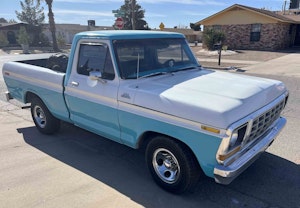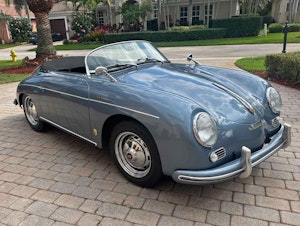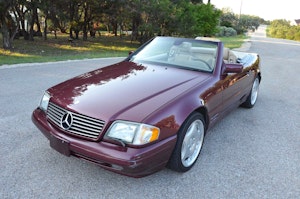Media | Articles
Avoidable Contact #104: Build a better Miata and the world will beat a path to the worse one

Last week, while responding to my article about early-Miata appreciation, a reader asked for my opinion on the Fiat 124 Spider. Well, I am happy to oblige, and here goes:
The ND-Miata-based Fiat 124 Spider is brilliant. You should buy one.
Well, that wraps up this week’s episode of Avoidable Contact! Thanks for reading! Tip your waitress! Try the veal!
Oh, wait … you want to know why? Or, perhaps, why you would buy a Spider over the ND Miata? Well, stick around.
(Brief digression: I cannot help but notice that the old standup comedy taglines repeated above are potentially offensive to the reader. I apologize. Tip your server! Try the cricket flour!)
Marketplace
Buy and sell classics with confidence
To explain how FIAT got the 124 Spider right, we first have to explain its relationship to the ND-generation Mazda Miata, and discuss how Mazda (arguably) got the ND wrong. This story starts with the third-generation (NC) Miata, a car that was in many ways a cut-down droptop version of the larger four-seater suicide-door rotary-powered RX-8. The NC endured a lot of criticism from people who said it was simply too large and too heavy, particularly from the “buff books.” This criticism was ridiculous on its face, because the NC was only about 50 pounds heavier than the final-year NB Miata, while being faster, more spacious, more reliable, easier to maintain, and just plain better in almost every way that mattered. If you bought the cheapest NC Miata on the lot in 2006, you got a car that was slightly faster and considerably grippier than the alpha dog NB, the turbocharged 2005 Mazdaspeed Miata.
All of that being said, Mazda took the criticism to heart, and vowed that the ND would be lighter than both the NC and the final NB models. This was accomplished through a painstaking program-wide policy of weight reduction that put particular focus on the running gear. The car was optimized around a high-revving 1.5-liter Skyactiv four-cylinder. I drove that variant in Barcelona before the ND Miata’s USA debut and had no trouble proclaiming it to be the greatest Miata of all time.
Unfortunately, we didn’t get it.
Instead, we got a two-liter Miata with a strangled 2.0 from the Mazda3. Instead of 129 horsepower and 110 pound-feet of torque in a package that could cheerfully rev to 7500 rpm, the American Miata had 155 horsepower and 148 lb-ft of torque, calling a halt to the party at a breathless 6800 rpm. The urban legend about this—and it might even be true—is that we were supposed to get the 1.5-liter as the only engine until the eleventh hour, at which point the sluggish two-liter got tossed in to help the Miata keep up with city traffic.
There were two consequences to this last-minute engine switch. The first was that the “ND1” 2016 Miata didn’t feel quite as lively and enthusiastic as I’d hoped, given my experience with the 1.5-liter. The second was that the torquier engine took a considerable toll on the Miata’s weight-optimized running gear, from the fragile transmission to the four-bolt wheel hubs. This was most apparent in the MX-5 Cup race series, where teams started bringing as many as three spare transmissions per car to each race, but it didn’t go unnoticed in dealer service departments, either.
Enter FIAT and its bizarre arrangement to have Mazda build ND1-based “124 Spider” cars in Hiroshima, right next to the standard Miata. The Spider offered several tangible advantages over its house-brand sibling. To start with, it had nicer interior materials, better seats, and more color choices. It had a longer nose with classic Italian styling, and plenty of chrome detailing available. Most importantly, it had the 1.4-liter turbo FIAT engine with the heavier-duty transmission from the NC Miata, putting out 160–165 horsepower, depending on trim, and revving to an even less ambitious 6500 rpm.
Five years ago, I had a chance to compare the 124 Abarth and the ND1 Miata directly on track. The Miata was faster that day, courtesy of brakes with better fluid in the calipers, but it was a close-run thing. On the street, however, the FIAT was the clearly better choice. It rode better, had more power available in daily-driving situations, and even had a quieter convertible top, thanks to some extra insulation.
If you drove a 124 and a Miata back to back on your commute, you’d want the “Italian” car from Hiroshima instead of the Japanese one. This would be particularly true if you chose one of the fine chrome-trimmed luxury variants, with their buttery-soft seats and expensive-feeling controls. The styling of the two cars is probably a subjective matter. I think the black-hood 124 Abarth looks very fierce, while the upscale variants have a classic ’60s feel to them. The Miata’s styling is completely different and very much a unique thing, recalling no previous Miata or even Mazda. Most people have a distinct preference; in offhand polls, the 124 seemed slightly more popular, particularly with women.
For 2019, Mazda put the high-revving head of the 1.5-liter Skyactiv on the 2.0, boosting power to 181 hp and increasing the thrill of driving the thing by some subjective, but considerable, amount. FIAT had no answer; by then they were already thinking about pulling in their horns across the United States. The 124 Spider was discontinued for 2021. It’s a used car now …
… and it’s a heck of a deal, something you can’t say about the vast majority of used cars on the market right now. If you don’t need an Abarth, low-mileage examples can be had all day for 16 grand. Add three or four thousand dollars for an Abarth. This modest sum gets you a car that is very nearly as reliable as a Miata. But wait, as they say, there’s more. If you’re not obsessed with reliability, it’s no sweat to tune the 1.4-liter turbo engine to 200 horsepower or thereabouts. A turbo swap and tune puts you at 240 hp, which is really past the envelope of the drivetrain but probably won’t leave you stranded unless you really drive it hard for extended periods.
The news gets even better if you like (or need) an automatic transmission, because while neither the ND1 nor the updated ND2 pair terribly well with a slushbox, the 124 Spyder’s turbo engine seems born for the task. Most of them have a full 184 lb-ft of torque, a comfortable margin above the ND2’s figure of 151 lb-ft and available across a far broader rev range. It’s perfectly happy with a slushbox.
Of course, all the Miata chassis and brake upgrades in the aftermarket work for the FIAT as well.
To sum up: As a used-car proposition, the 124 Spider is better at going fast than the Miata, and it’s also better at going slow, and it’s cheaper, and to some people it’s better-looking. Yet it sat forlorn in showrooms as people fought tooth and nail to get an allocation for the 30th Anniversary Miata, including my spouse. What gives?
If I had to blame one factor for the 124’s early demise, it would be the dealers. FIAT stores are few and far between. They don’t exactly inspire confidence in buyers. There’s some irony to this, because fifty years ago the Italian brand had a pretty decent network and things were so dismal with Mazda’s nationwide distribution that most people wound up experiencing the company via the badge-engineered Ford Courier minitruck. Oh well. Times change.
Now that values for decent 2017 Spiders are about in line with those of, say, a #2 condition 1993 Miata, it’s worth asking which would be the better buy. I can’t speak for the investment potential, but for any sort of regular or semi-regular use the FIAT is going to be the winner hands-down. It’s about 200 pounds heavier than an NA Miata, but every one of those is put to good use. It will drop the older car on a racetrack, autocross, or back road. It is easier to operate in traffic, has a better stereo, better air conditioning, nicer seats, all that jazz. It’s made in the same factory to similar if not better standards.
No, it doesn’t have the perfect proportions of an original 124 Spider, but face it: The NA Miata ain’t no Elan in that regard, either. Most of the parts should be around for a while, since an American-built version of the engine is found in the Dodge Dart, and the rest of it is pure ND (or NC) Miata. It might not be that easy to find certain body panels 20 years from now. If that concerns you, then you might be better off with a Honda CR-V.
I never cared much for the GNU-style acronym MIATA (Miata Is Always The Answer), but let’s face it: Unless you’re one of those stout-hearted American heroes who is willing to rock a 4+3 Nash-box C4 Corvette, the little Mazda is a pretty unimpeachable answer to the sports car question. For many of us, however, the Hiroshima FIAT is an even better answer. Give it a shot! Try the veal! Take my wife(’s fourth Miata), please!









